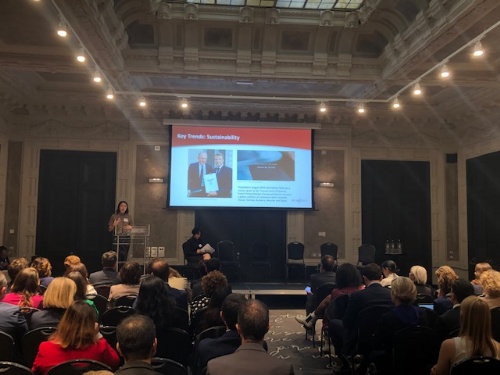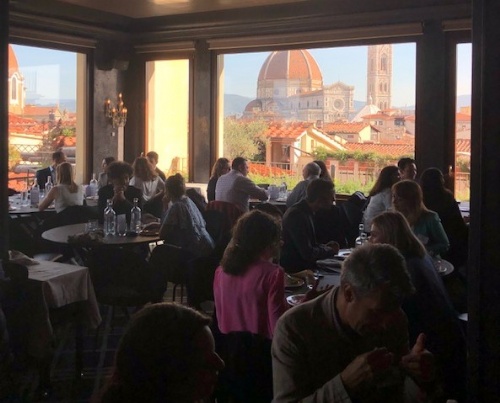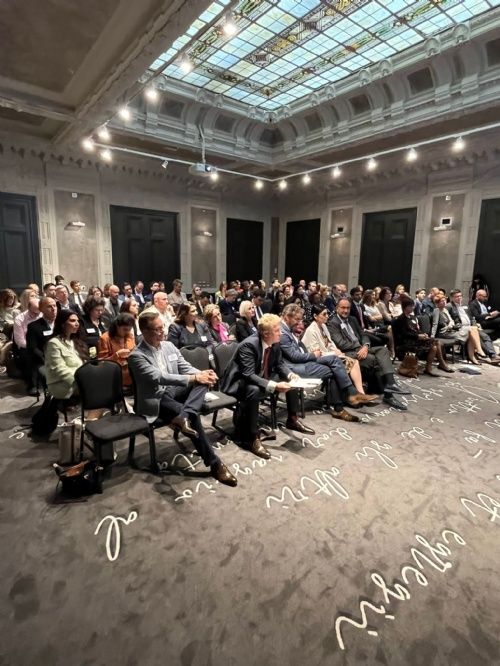Now in its twelfth year, Class 46 is dedicated to European trade mark law and practice. This weblog is written by a team of enthusiasts who want to spread the word and share their thoughts with others.
Click here subscribe for free.
Who we all are...
Luxury Brands: Cross-over collaboration
 The fourth MARQUES Luxury Brands Symposium is taking place in Florence, Italy. Welcoming about 100 attendees this morning, MARQUES Chair Joachim Hofmann said that trade marks are very important for the luxury sector as they demonstrate prestige and quality.
The fourth MARQUES Luxury Brands Symposium is taking place in Florence, Italy. Welcoming about 100 attendees this morning, MARQUES Chair Joachim Hofmann said that trade marks are very important for the luxury sector as they demonstrate prestige and quality.
This year’s event is covering topics including new technologies, sustainability and collaborations. In the first presentation, keynote speaker Laura Ru Yun Pan, Lecturer on International Management, SDA Bocconi School of Management (pictured right), talked about “Luxury’s new normal”.
During the pandemic, she said luxury companies expected a 50% decline but experience showed that the luxury sector was very resilient: by 2021, most luxury companies had already bounced back to pre-pandemic levels. “They did this by linking not just to brands but to a lifestyle,” said Laura.
She cited figures from luxury groups such as LVMH, Kering, Richemont and Ferrari showing significant increases from 2020 to 2021, saying: “Post-pandemic, luxury companies are doing really well.” The growth has been attributed to “revenge shopping” though this is only a short-term trend. Growth has also come from new consumers and new income streams, increases in prices and profit margins, social media marketing and new sales channels. “It’s a big shift for luxury’s digital transformation,” said Laura.
She identified three pillars driving the change:
- sustainability (including the Fashion Pact, the circular economy and authorised resale) and social justice;
- brand extensions and collaborations, including new shopping/lifestyle experiences and partnerships with celebrities, artists, other industries and technologies; and
- exploring new technologies, such as blockchain, gaming and the Metaverse, crypto and Web 3.0.
“I’m sure we’ll see more and more about these topics in the next five to 10 years,” she concluded.
Cross-over collaboration
 The day’s first panel focused on cross-over collaboration. It comprised Leo Longauer, Deputy Director Market Protection of LVHM group, France; Debora Zeno, IP & Brand Protection Associate Manager, Bulgari S.p.A, Italy; Nina Dorenbosch, Bird & Bird, Associate, The Netherlands; Alessandro Cicognani, Licensing and Corporate Partnership Director, Ducati Motor Holding spa, Italy; and Silvia Pugnale, Legal Specialist, Nestlé, Italy. The panel was chaired by Noemi Parrotta of Spheriens in Florence
The day’s first panel focused on cross-over collaboration. It comprised Leo Longauer, Deputy Director Market Protection of LVHM group, France; Debora Zeno, IP & Brand Protection Associate Manager, Bulgari S.p.A, Italy; Nina Dorenbosch, Bird & Bird, Associate, The Netherlands; Alessandro Cicognani, Licensing and Corporate Partnership Director, Ducati Motor Holding spa, Italy; and Silvia Pugnale, Legal Specialist, Nestlé, Italy. The panel was chaired by Noemi Parrotta of Spheriens in Florence
Debora said that Bulgari’s history of collaboration goes back to the 1990s. The aims of collaboration include to reinterpret timeless icons, to celebrate an event/anniversary, to boost uniqueness and raise desirability and to give opportunities and share common values.
Bulgari’s collaborations have spanned architecture, art and music, automotive, Italian institutions and fashion designers. The longest-lasting collaboration is the #GIVEHOPE partnership with Save the Children which has raised more than €100 million so far.
“We want to have collaborations but they have to respect our brands, heritage, culture and values,” said Debora, explaining: “We keep control of the use of all our IP rights and try to obtain full assignment of IP rights on new creative elements. And we never compromise on the savior faire and the highest quality of products.” Bulgari also aims to preserve a selective distribution system and to prevent any damage to its reputation, image and/or business.
 |
| The Luxury Brands Symposium is being held in the Grand Hotel Baglioni, and delegates enjoyed a view of Florence’s Duomo at lunchtime. |
Ducati is about selling dreams and emotions, rather than products to get you from A to B, said Alessandro in his presentation, which focused on brand extension. “We are an upper premium brand, and we want to be inclusive rather than exclusive. This is part of our heritage,” he explained. “You always have to keep in mind: who is your consumer? And you should not betray them. If we do this, we will not face any problems.”
That means being true to the brand values of style, sophistication, performance and trust. Brand extensions include licensing, co-branding, events, experiences, academies, apparel and the Ducati Museum.
Brands in the Nestlé group are also open to cross-collaboration, said Silvia: “We decided to find cross-collaboration even with companies operating in very different sectors to ours, when they share our values.”
In 2022, Nestlé’s BACI PERUGINA chocolate pralines mark their 100th anniversary, and the company is celebrating the occasion with another Italian brand, Dolce & Gabbana. “Our partnership is founded on common values, even if the brands are quite different,” said Silvia. Dolce & Gabbana provided creativity leading to limited editions chocolates sold with special logos.
Silvia explained any cross-collaboration agreements must include IP clauses providing protection for the brand image, compliance to ensure respect of Nestlé’s IP rights, representations and warranties as to non-infringement and a detailed approval process for use of licensed trade marks.
Taking a closer look at the legal issues, Nina said: “Many collaborations are temporary so you also need to address what happens after the collaboration.” She said the first step in any collaboration should be to sit down with the business and understand the aims. Questions such as who is doing the design will determine where the IP is allocated.
 Nina distinguished between “foreground IP” and “background IP”: “This will influence what you want in your cross-licence, what needs to be registered and the due diligence of each party’s portfolio.” For example, you may need to add classes or territories to some trade mark registrations. Exclusivity, confidentiality, quality standards, warranties and notification requirements are also things that should be addressed in the agreement.
Nina distinguished between “foreground IP” and “background IP”: “This will influence what you want in your cross-licence, what needs to be registered and the due diligence of each party’s portfolio.” For example, you may need to add classes or territories to some trade mark registrations. Exclusivity, confidentiality, quality standards, warranties and notification requirements are also things that should be addressed in the agreement.
Nina also asked: what if things go wrong? “It’s important to think about that when you’re drafting the agreement.” That means including termination clauses, options for removal of references to the collaboration and the possibility of arbitration to resolve conflicts.
Another challenge that arises from the growth in collaborations is that policing counterfeits can be harder, said Leo Longauer of LVMH, as you have to ask: is the product real or a fake? And it can be hard to tell. “Counterfeiters can invent new collaborations or brand extensions, including in the Metaverse, he explained: “We need collaboration with experts in the field.”
In a final contribution to this panel, Christoph Bartos of the EUIPO Boards of Appeal stressed the importance of public perception under Article 7 and Article 8 of the Trade Marks Directive, and the need for trade mark applicants/owners to demonstrate brand reputation and whether there is consumer confusion and similarity. “If you want to influence the decision taker, submit the evidence,” said Christoph. Citing the recent ZORAYA case, he also encouraged associations to submit amicus curiae briefs in appropriate cases.
Posted by: Blog Administrator @ 17.44Tags: Luxury brands, Florence, ,


 Sharing on Social Media? Use the link below...
Sharing on Social Media? Use the link below...Perm-A-Link: https://www.marques.org/blogs/class46?XID=BHA5122

